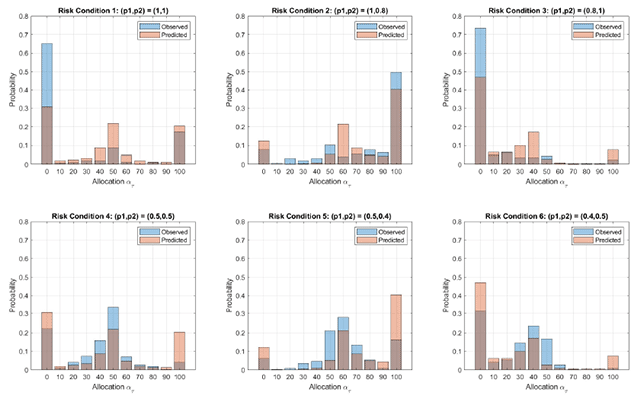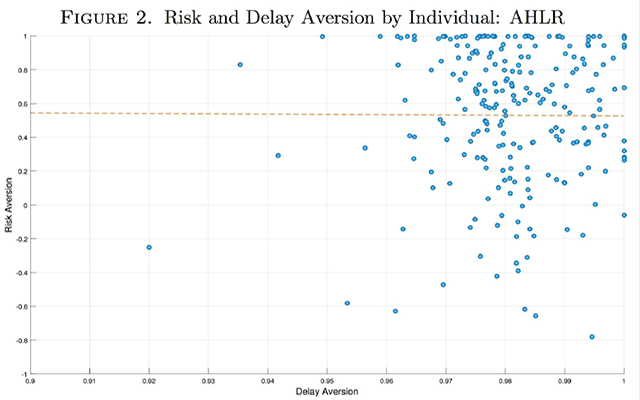The "la Caixa" Foundation supports ground-breaking research at the Barcelona School of Economics through the "la Caixa" Foundation Research Grants on Socioeconomic Well-being.
Project overview
The estimation of the attitudes of individuals with respect to risk-taking and time discounting is a fundamental question in economics and the social sciences in general. A proper understanding of the potential consequences of tax reforms, regulations of health and pension plans, the design of financial markets, and innumerable other crucial aspects of normal modern life, requires of a good understanding of the behavior of the population when confronting risks, and consequences that unfold over time. This project aims to develop a novel, theoretically robust, technique to estimate both risk and time preferences jointly, and to then apply the technique to a rigorous empirical scrutiny.
Main results
- Develop a novel theoretical framework for the joint treatment of risk and time preferences in the standard deterministic setting
- Develop the stochastic version of the deterministic theoretical framework
- Create and analyze a meta dataset of experimental studies of risk and time preferences
Summary, output, and dissemination
- Research summary
-
Economic situations jointly involving risk and time pervade most spheres of everyday life. To illustrate, financial decisions of any sort involve typically a component of risk and evolve over time. Health attitudes of citizens also have these features. Picture, for example, smoking, drinking, or dieting behaviors. Another direct example of the pervasive relevance of risk and time considerations is education. The returns to education take place mainly in the future, and are uncertain. But also at the institutional level, risk and time considerations are very prominently present. Investments in public facilities, tax reforms, pension regulations, public budget, etc. It is clear, then, that we need to have a tractable and sound framework for the joint treatment of risk and time preferences. This has been exactly the objective in this research project.
Given the relevance of the subject matter, the reader may believe that we have a wealth of sound techniques that enable a proper understanding of risk and time preferences. The truth, however, is that this is far from being the case. In previous recent work, Apesteguia and Ballester (2018) show that most of the standard frameworks used in the independent study of risk and time preferences have counterintuitive properties. Apesteguia and Ballester show that the standard frameworks may generically predict higher choice probabilities for a risky lottery over a safe alternative in individuals with more risk aversion. This makes it impossible to interpret the model in terms of stochastic risk aversion. Apesteguia and Ballester (2018) also show that the random parameter model respects the notion of more risk aversion in expected utility and of more delay aversion in exponential discounting, while leaving unanswered the question of how to treat risk and time preferences jointly. To the best of our knowledge, the paper that we have produced in the context of this research project, Apesteguia, Ballester and Gutierrez (2019), is the first paper to lay down the theoretical properties of a stochastic model of risk and time preferences in terms of their stochastic comparative statics.
In Apesteguia, Ballester and Gutierrez (2019) we develop a sound framework for the joint analysis of risk and time preferences. We study several deterministic models of risk and time that can be used as a basis for estimation exercises; establish their risk and time comparative statics; bring them into the framework of random utility models; and empirically illustrate their potential using several prominent experimental datasets. Our framework offers a unique tractable tool for gaining a deeper understanding of risk and time preferences, a cornerstone of economics.
As examples of practical lessons to be learnt with our framework, we comment on the results we obtain with the influential experimental dataset of Andreoni and Sprenger (2012b). The choice data appears challenging at first. It has a significant fraction of corner choices, located at both ends of the choice range, and a significant fraction of interior choices. Previous attempts in the literature have had great difficulties in accounting for such heterogeneous choice data. However, as illustrated in the figure below, our stochastic implementation of what can be considered the simplest possible model of risk and time preferences, the discounted expected utility model, already allows us to account for the observed choice patterns remarkably well. The reason for this is that our framework is built upon the consideration of heterogeneous preferences, some of which predict corner choices and others interior ones. As can naturally be expected, the more flexible models studied in the paper capture some other features of the data even better.
Another interesting finding is the extent of individual heterogeneity in terms of the attitudes towards risk and time. Using the dataset of Andersen et al (2008), Figure 2 below shows a scatter-plot with the estimated individual median of risk and discount factor for each of the 253 subjects in the sample. The figure clearly shows that there is substantial heterogeneity of preference across the population. This is a very important finding to take into consideration when designing policies to which individuals may react differently depending on their risk and time attitudes.
The main aim of this paper is to develop a simple, tractable and sound stochastic framework for the joint treatment of risk and time preferences that will enable the proper estimation of risk and time attitudes. This involves three broad steps.
In step 1, we analyze several deterministic models of risk and time preferences, establish their formal relationships, and characterize their comparative statics.
In step 2, we embed these deterministic models within the random utility framework, show that the comparative statics of the deterministic models extend immediately to this stochastic setting, and discuss how to estimate them.
In step 3, we implement our stochastic framework to estimate risk and time preferences using datasets from a diverse set of influential experimental papers. Namely:
- Andersen, Steffen, Glenn W. Harrison, Morten I. Lau, and E. Elisabet Rutström. 2008. “Eliciting Risk and Time Preferences.” Econometrica 76 (3): 583–618.
- Andreoni, James and Charles Sprenger, “Risk Preferences Are Not Time Preferences,” American Economic Review, 2012, 102 (7), 3357–3376.
- Andreoni, James and Charles Sprenger, “Risk Preferences Are Not Time Preferences: Reply,” American Economic Review, 2015, 105 (7), 2287–2293.
- Cheung, Stephen L. 2015. “Comment on ‘Risk Preferences Are Not Time Preferences’: On the Elicitation of Time Preference under Conditions of Risk.” American Economic Review 105 (7): 2242–60.
- Coble, K.H., and J.L. Lusk. 2010. "At the nexus of risk and time preferences: An experimental investigation," Journal of Risk and Uncertainty, 41, Issue 1:67-79.
- Miao, Bin and Songfa Zhong, “Comment on ‘Risk Preference Are Not Time Preferences’: Separating Tisk and Time Preference,” American Economic Review, 2015, 105 (7), 2272– 2286.
- Publications and working papers
-
- Jose Apesteguia and Miguel Ballester, “Monotone Stochastic Choice Models: The Case of Risk and Time Preferences”, Journal of Political Economy, 126(1):74-106, 2018.
- Jose Apesteguia, Steffen Huck, Jörg Oechssler and Simon Weidenholzer, “Imitation of peers in children and adults”, Games, Vol.9, No 1, Art. number 11, March 2018.
- Jose Apesteguia, “Measures of rationality and welfare for behavioural decision-makers”, Els Opuscles del CREi, July 2018.
- Jose Apesteguia, Miguel Ballester and Angelo Gutierrez, “Random Models for the Joint Treatment of Risk and Time Preferences”, Barcelona School of Economics Working Paper.
- Conferences, workshops and seminars
-
Workshops
- “Structural Behavioral Economics”, Briq Conference, Bonn, June 2019
- “Measuring Individual Well-being Workshop”, Brussels, May 2019
- 72nd Scientific Meeting of the Societat Catalana de Neuropsicologia, Barcelona, June 2018
- BRIC (Bounded Rationality in Choice) Workshop, Columbia University, June 7-8, 2018. This is the most prestigious workshop in the intersection of choice theory and bounded rationality.
- Workshop in Stochastic Choice, BSE Summer Forum, June 2018 and June 2019. Title: “Random Multi-Parameter Models for the Joint Treatment of Risk and Time Preferences”.
Invited departmental seminars
- University of Oxford, October 2018
- Royal Holloway, University of London, September 2018
- University of Edinburgh, July 2019
- University of Zurich, April 2019
- University of Surrey, March 2019
Research stays
- Department of Economics, University of Edinburgh, July 2018 and July 2019
- Department of Economics, University of Oxford, November 2017 and December 2018
- Luxembourg Institute of Socio-Economic Research (LISER), February 2019



